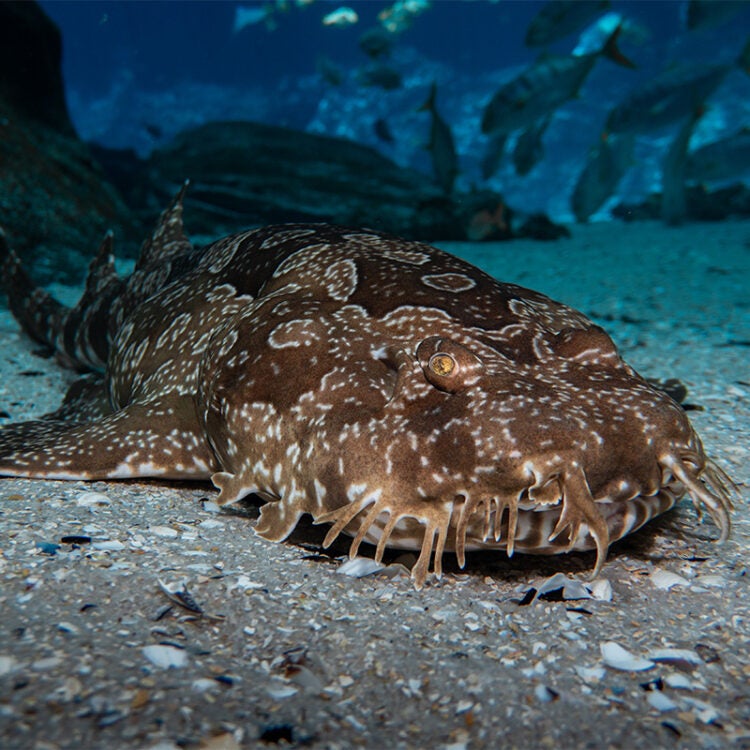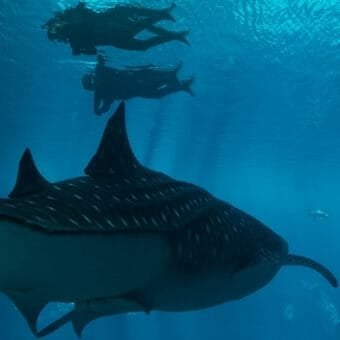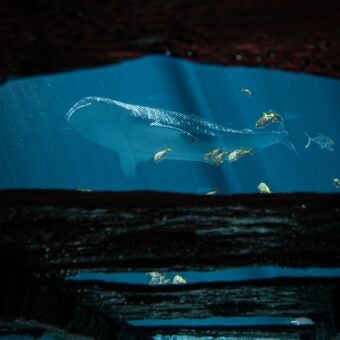-
Size
10.5 feet (3.2 m) -
Diet
Bottom invertebrates and bony fishes -
Range
Indian Ocean, Southern and Western Australia -
Habitat
Coral and rocky reefs, sandy bottoms
Physical Characteristics
- The spotted wobbegong can reach a maximum length of about 10.5 feet (3.2 m).
- This shark has a distinctive body shape- its head and body are very flattened and the pectoral and pelvic fins are broad. It has a wide mouth and there is a large crescent-shaped spiracle behind each eye.
- A few branching skin flaps run continuously from the pectoral fins around the front of the head forming a lace-like beard below the mouth.
- The species possess a spiracle, which allows it to breathe while remaining motionless on the bottom.
- The body and fins display a variegated pattern featuring dark saddles on the back and densely covered with pale ring-shaped markings. There is a dark triangular mark between the eyes.
Animal Fact
The spotted wobbegong possess a spiracle, which allows it to breathe while remaining motionless on the bottom.
Diet / Feeding
- A nocturnal feeder that preys on bottom invertebrates and bony fishes.
Range / Habitat
- Occurs in the eastern Indian Ocean, Southern and Western Australia, Japan and the South China Sea.
- Found in warm waters on the continental shelf from intertidal areas to depths of about 360 feet (110 m).
- This species is commonly found on or near the bottom of coral and rocky reefs, under piers, and on sandy bottoms. It has been observed in water barely deep enough to cover it.
Reproduction & Growth
- Ovoviviparous- fertilization of eggs occurs internally and the young develop within the female and are born fully formed.
- Females can produce up to 37 pups per litter.
Conservation Status
- “Least Concern” on the IUCN Red List.
Additional Information
- The spotted wobbegong is a master of camouflage. Resting quietly on the bottom, this species is almost undetectable. Its flattened body, enlarged pectoral and pelvic fins drape over the rocky or coral substrate, barely adding to the height of the bottom. The shark’s variegated brownish-grey markings and pale ring-like spots break up the body into irregular shapes that blend with its surroundings. Even the eyes, which would ordinarily be easily detectable, are surrounded by eye-shaped markings that make them difficult to identify. A beard of fleshy tassels further hides the outline of the shark’s head, making it very hard to tell where the animal stops and the bottom begins.
- This wobbegong appears to favor specific caves to rest in during the day. These caves are often shared with small schooling fishes.
- Its flesh is sometimes eaten and its skin is sometimes utilized for leather.
- The species will bite if stepped on or provoked.
- The name “wobbegong” is Australian aboriginal in origin, but its exact meaning is unknown. It is speculated that it may mean “living rock.”






